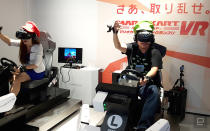This Japanese VR arcade put me inside 'Mario Kart'
Fans of 'Dragon Ball' and 'Evangelion' can join their favorite characters in virtual reality.
Back when Bandai Namco opened its first VR arcade in Tokyo last April, I was keen to check out its various HTC Vive-powered VR games. My first ride there would have been Gundam VR: Daiba Assault, just so I could get a taste of what it's like hitching a ride on a Gundam's hand. The problem was by the time I got to the city the following month, this pop-up store already had a three-month waiting list, and I never got around to visiting before it closed in October.
Luckily, as of last Friday, VR Zone is back in new form. Not only is it now the world's largest VR arcade, but it's also moved to Shinjuku, a more accessible downtown area in Tokyo. And this time, it's staying for two years. More importantly, the arcade has added some widely anticipated games that may sound familiar to you -- namely, Mario Kart Arcade GP VR, Dragon Ball VR: Master the Kamehameha and Evangelion VR: The Soul Seat. As a bonus, Gundam VR has also been brought over from the previous site.
It's hard to miss VR Zone Shinjuku when you're walking around the famous Kabukicho entertainment district. At night, you'll see this brand new building showing off colorful lights and the occasional wall projections. (For those familiar with the Yakuza game series, VR Zone is located at the same site as the bowling alley in Kamurocho.) The two floors have a total space of about 3,500 square meters (37,600 square feet), and it's expected to serve 1,500 visitors per day -- about five to seven times as many as the old Odaiba store.
According to Bandai Namco executive producer Junichirou Koyama, the expansion is intended to ride on VR's increasing popularity among families, as observed by his team back in Odaiba. In the process, his team focused on multi-player VR, which gets a more impressive reaction from both the players and the spectators. Koyama added that there are still relatively few people who have experienced VR, but with Bandai Namco's iconic IPs, he's confident that VR Zone will encourage even more people to give VR a try, just so they get to play as their favorite characters. If all goes well, the company may roll out more VR arcades across the country and maybe even overseas.
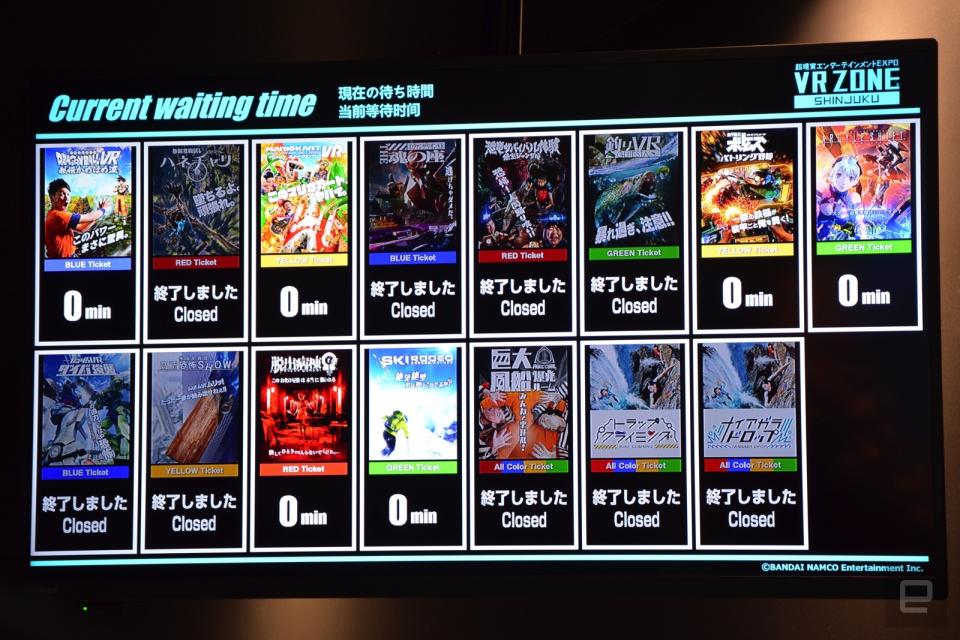
Unlike the appointment-only Odaiba store, VR Zone Shinjuku lets you buy tickets at the door, but only if reservations aren't full that day. For that reason, the arcade still recommends booking in advance, especially for the "1 day/4 Ticket set," which costs 4,400 yen (about $40) and gives you access to four games. The catch is that you can't just pick any four games; you have to choose one of the three games pre-defined by each of the four colored tickets. That said, if the store isn't too crowded that day, you may be able to buy a single VR game ticket for 1,200 yen (about $11) afterward, so that you can pick another game from that list, or even go back to a title you really enjoyed.
It's worth pointing out that on top of the game tickets, you'll also have to buy admission tickets: 800 yen (about $7) per teenager or adult (so anyone age 13 and older) and 500 yen (about $4.40) per child (between the ages of 6 and 12); children under the age of 6 can enter for free. Once you're in, you can stay for as long as you want.
All told, the VR arcade features 12 game titles, but there are also three non-VR physical games set up next to the in-store restaurant to let folks take a break from VR.
Mario Kart Arcade GP VR

Naturally, as soon as my tour ended, the first game that I dashed to was Mario Kart. There were two sets of four driving simulators, with car number 1 designated as Mario, number 2 as Luigi, number 3 as Peach and number 4 as Yoshi. My Taipei colleague Ross Wang and I hopped in and were given a pair of Vive Tracker gloves to wear. That allowed us to wave at each other as well as to grab and use weapons -- a shell, a banana or a hammer.
Once I put on my Vive headset, I found myself inside the body of Luigi seated in a go-kart. It took a while for the others to be strapped in, but I didn't mind, as I was having fun by merely looking around the vibrant world of Super Mario Bros. Then the engine kicked in, and I realized that my seemingly ordinary ride also included motion feedback. Suddenly, Bowser and Wario came out of nowhere and rudely pushed in front of me. I thought to myself, I'll definitely be throwing some koopa shells today.

Even though I had never played Mario Kart in a driving simulator before, this faithful rendition made the experience feel surprisingly familiar -- from the graphics, the music, how the race started, the steering, the obstacles, the crashes, and even how I finished the race (and I'm proud to say that I was the champion both times). The only major differences were having to reach out to the weapons that were hanging on floating balloons and then either throwing or striking them at my foes, but that felt natural. I was simply in awe of the fact that the cartoonish racing game that I grew up with had become very real.
Dragon Ball VR: Master the Kamehameha

Mario Kart was clearly a tough act to follow, but the next title didn't disappoint. Dragon Ball VR is a game that requires two players and you're both taught how to master the iconic Kamehameha attack move from the game's namesake anime. The preparation was a little more complicated than the other rides, though, as I had to put on a total of five Vive Trackers: one on each foot, one on each hand and one on the back of my waist. Just to be safe, the waist belt was tied to a pole behind me to soften any forward fall. The gloves also had chunky rumblers wired to the back, which I found to be a little uncomfortable at first.
Soon after the game started, I was greeted by Goku who served as my mentor (the booth next door featured Vegeta instead). Given my limited proficiency in Japanese, I could not understand a word of Goku's instructions, but I did figure out that he was teaching me the correct posture for shooting small Ki blasts. With every blast I shot out, the gloves rumbled accordingly. This felt cool indeed, but I had terrible aim and managed to almost tear down the Martial Arts Temple in the first scene. I think it was because I didn't squat low enough.

Looking disappointed, Goku then teleported me to the wild where I could shoot at large rocks instead, and that was where he taught me the ways of Kamehameha. First, I had to build up my Ki energy by squatting slightly and pulling my fists closer to my waist. I could feel the platform vibrating as if my Ki were really shaking the earth, and more impressively, there was actual wind blown at me to go with the glowing updraft in the game. In the next step, I had to cup my hands together on one side of the waist to concentrate the Ki into my palms, and I could tell my beam's readiness both visually and by how hard my palms were rumbling.
There were a couple of occasions when I accidentally lost all my Ki, presumably due to my bad posture, forcing me to restart the process. At least that way I proved that this game does have some challenges, as opposed to just letting one goof around in the anime setting. When my beam was fully charged, Goku and I yelled the iconic "Ka-me-ha-me-HA!" scream, and then we pushed our hands out to shoot our Kamehameha beams. Boom! I destroyed a hill and left a massive trail on the ground. I'm not actually sure if the yelling made any difference, but who cares? This is Dragon Ball.

After a few more practice shots, I was teleported to the battlefield to face the player next door. It was then merely a matter of who shoots first with the right aim -- there was a fair bit of distance between the two of us. Alas, my first shot was too low and I ended up with a massive trench in front of me. As I desperately tried to charge up my second Kamehameha, my enemy sent a perfect beam right into my face, which was accompanied by a quick gust of wind in the real world. I died. Luckily, it wasn't game over just yet, as the game shortly resurrected me back onto the battlefield. After another missed aim, I eventually redeemed myself and defeated my opponent right before the game ended.
Evangelion VR: The Soul Seat
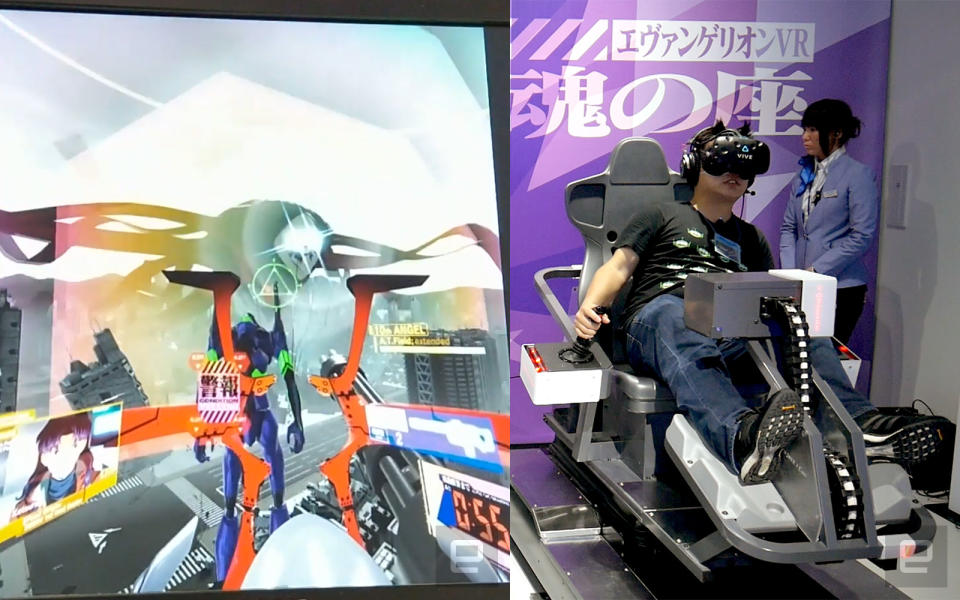
I continued my anime frenzy by jumping into Evangelion VR. This game places the player inside of one of the three most iconic Evangelion giant cyborgs: Unit-00, Unit-01 and Unit-02. The story here is that Tokyo-3, a fictional fortress city where paramilitary agency NERV is headquartered, is under attack by a creature called Zeruel, aka the Tenth Angel, so NERV deploys all three Evangelion units to the surface in the hopes of defeating the Angel.
Much like the rides made for Mario Kart VR, the Evangelion VR ones come with motion feedback and identical chairs, except the players have to lift their legs onto a leg rest to match the cockpit's design in the anime. Also, I didn't have to wear any Vive Tracker this time. To move around, you have to move both joysticks in the desired direction. Shooting is done with the right trigger using your head to aim, and you can equip a different weapon using the left trigger.
The game started off with me inside a dark Evangelion cockpit awaiting activation. To establish a neural link between the human pilot and the Evangelion unit, the cockpit is slowly filled up with a transparent orange fluid (it's known as "LCL," which is actually blood harvested from the Second Angel, Lilith). As a pleasant surprise, the ride enhanced this part of the experience by gently blowing cool air up my body as I watched the liquid creeping up. I was impressed even before I got to mobilize the Evangelion suit.
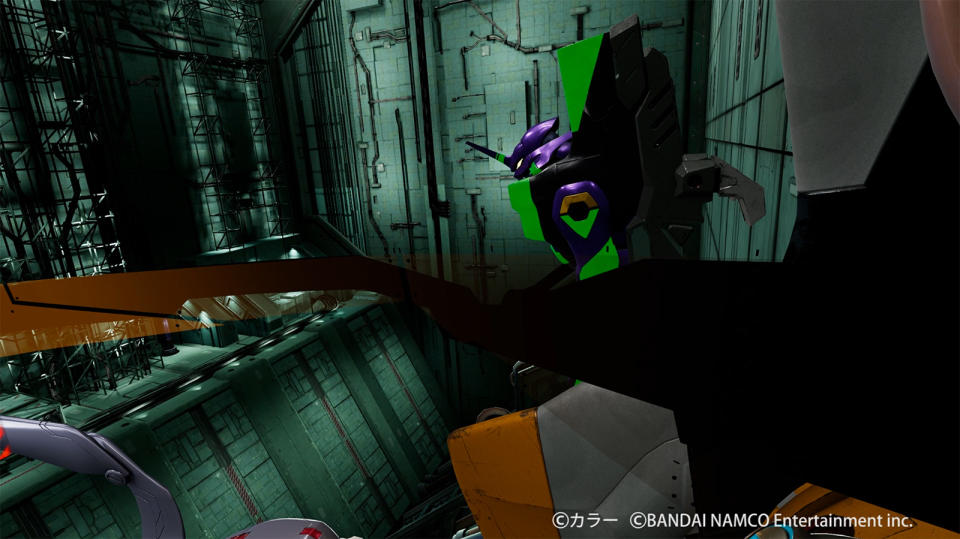
Soon, I was in sync with the suit and could see the heads-up display overlaying the outside world. Even though I was still being pushed out of the loading bay, I was already admiring the detailed graphics from a great height while my seat rumbled accordingly. Just as I was approaching the launchpad, I could also see my fellow Evangelion suits on both sides, and then we were rapidly shot up the shaft to the surface.
The massive Angel showed up soon after our arrival, which prompted us to run around and attack it from all sorts of angles while trying to dodge its beams. Truth be told, I had no idea which part of the Angel's body to aim my rifle at, but it didn't matter as I was mainly enjoying the immersiveness inside this massive cyborg, courtesy of fantastic view combined with motion feedback from the seat and the joysticks. It took me a while to realize that I could pick up more weapons from some of the walls, but by the time I got to equip a new minigun, the Angel had already penetrated the wall and totaled me in the process. As a pre-death humiliation, I was forced to watch the ugly beast slowly devouring me with its alien jaws.
Dinosaur Survival Run: Jungle of Despair

Just because the remaining VR titles lack the iconic IPs doesn't mean they aren't also fun. In fact, I would highly recommend a thriller game called Dinosaur Survival Run: Jungle of Despair, in which up to four players are tasked with rescuing plane crash survivors on an island where dinosaurs roam free (we never learn, do we?). It's pitch-black, human corpses are scattered all over the forest, and you're only given a self-balancing scooter -- simulated by a rumbling platform and a handlebar -- plus a flashlight with limited battery life. Basically, you can expect lots of screaming.
Hanechari
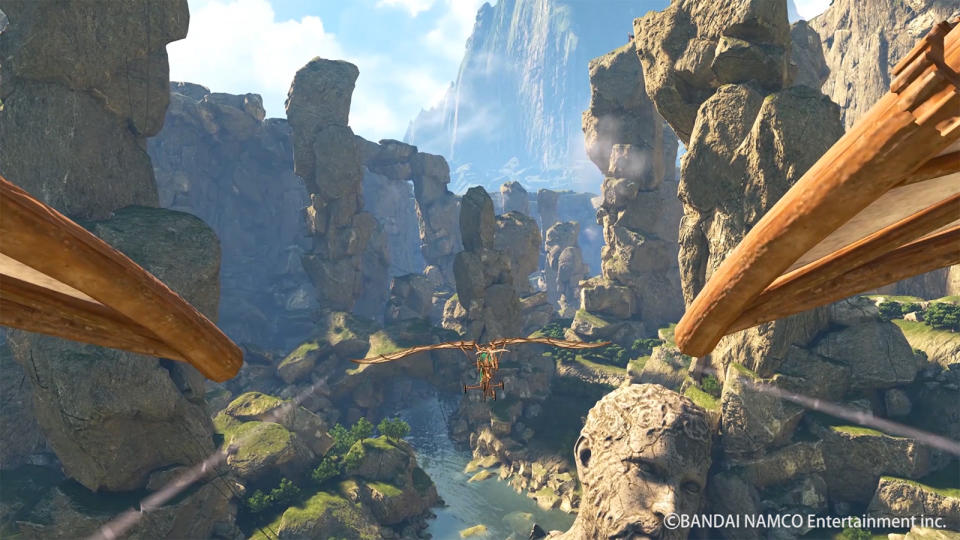
I also enjoyed Hanechari, which literally means "winged bicycle." You have to fly this vehicle on what's essentially a stationary bicycle. Even though this required some exercising, I was able to fully appreciate the stunning landscape in the game, and the breeze generated by the two fans in front of me made my three-minute flight more realistic. Most importantly, I managed to dodge all the obstacles to reach the castle in one piece.
Fishing VR: GIJIESTA

If you want something even less physically intensive, there's Fishing VR: GIJIESTA, which can be a one- or two-player game and is all about catching the biggest fish possible within six minutes. Although I'm not a fishing expert, the fishing rod controller and the fake scoop net made the experience a tad more realistic, plus it was also fun for others to watch as I wrestled the virtual fish. After letting two fish escape the hook, I managed to catch an 86-cm (33-inch) fish that set a new record for the day, until someone else came along with a 90-cm (35-inch) catch later.
Earlier games
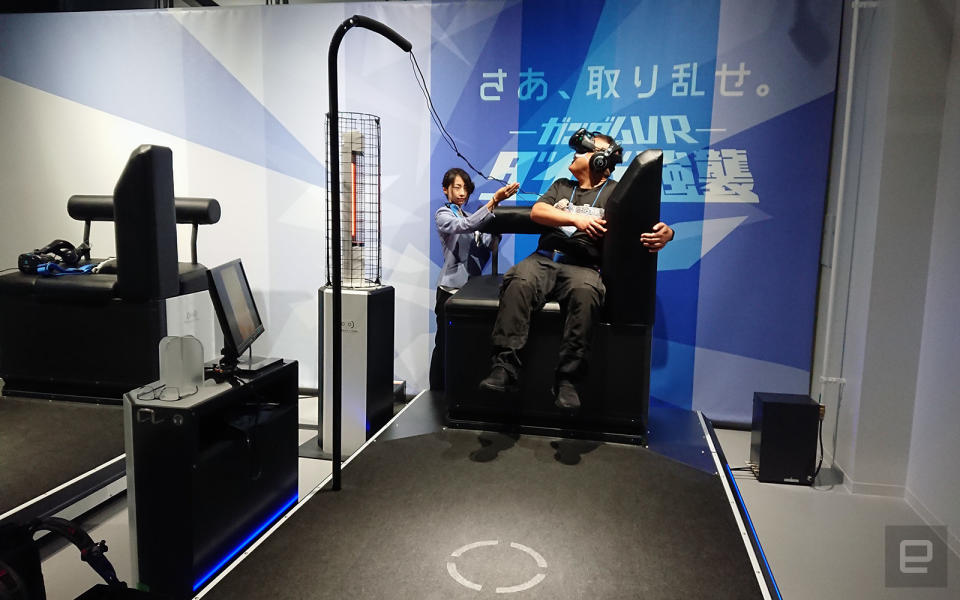
Given the limited time I had at VR Zone, I only managed to try the brand-new titles there, but I do hope to return for the games that were brought over from the old site. The most notable ones are Gundam VR and VR-AT Simulator: Armored Trooper Votoms Battling Dudes, both of which are based on their respective classic anime series though only the latter lets you pilot a robot.
The remaining games include Argyle Shift, which puts you inside the cockpit of a giant battle robot; Hospital Escape Omega, which pushes you through a bloody hospital on a wheelchair (I tried this at Tokyo Game Show last year and failed to hide my fear); Ski Rodeo, which is a ski simulator; and Fear of Heights: The Show, which requires the player to walk a plank protruding out of the top floor of a skyscraper.
Ghost in the Shell: Arise Stealth Hounds

One ride that wasn't available for demo at the time was Ghost in the Shell: Arise Stealth Hounds, as it wouldn't be ready until August. The setup was all shielded off so I couldn't even get a glimpse, but based on the official info, it will use MSI's VR One backpack for untethered gameplay in a 20-by-12-meter (65-by-40-foot) arena, and up to eight people can play in this two-team game. Much like the futuristic warfare in the anime, you'll be able to apply optical camouflage in the game, which makes me wonder if players will keep running into each other by accident.
Final thoughts
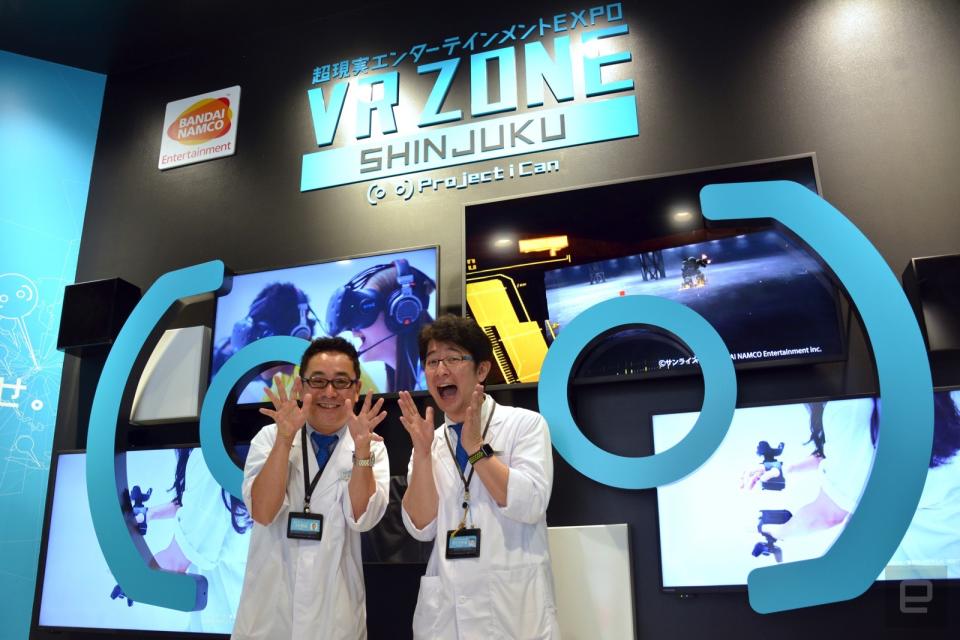
In the end, I spent about three hours playing games at VR Zone Shinjuku. I got around to six VR titles (two of which I played twice) that day, which was already a record for me, but I still wanted more. Nowhere else have I seen a VR arcade -- not even HTC's own Viveland -- matching the same level of scale and sophistication, so kudos to Bandai Namco for such dedication. That said, there's always room for improvement: I'd love to see VR Zone incorporate even more sensory features like haptic suits and thermo-electric devices, but what it's offering now is already leagues ahead of most other so-called VR arcades. Hopefully the lines won't be too long because I definitely have to go back at some point; I'm kicking myself for still having not tried Gundam VR.
Engadget Chinese's Taipei Editor Ross Wang contributed to this report.































